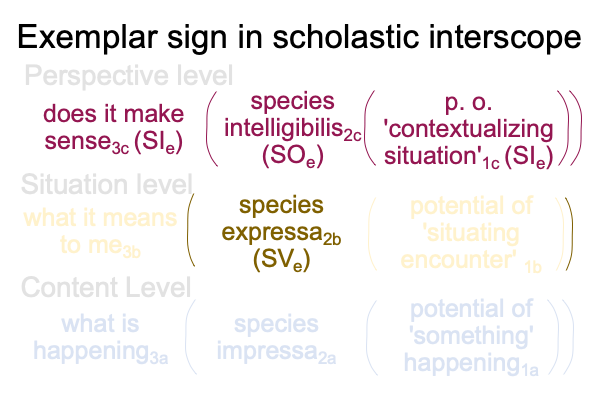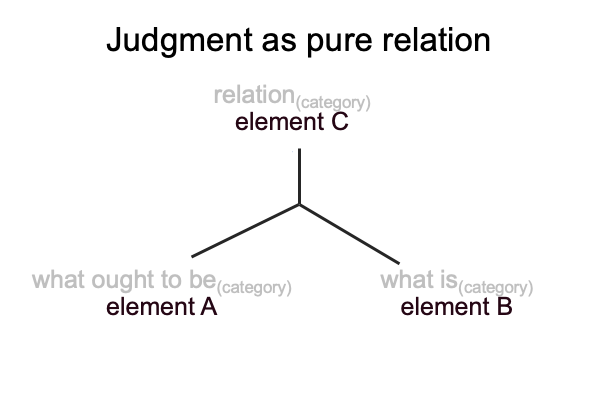0213 How are Tomasello’s three components in play in the exemplar sign embedded within the scholastic three-level interscope for the way humans think?
Here is a diagram.

0214 Species intelligibilis2c takes the phantasm2b off-line (1). How does this occur? Species intelligibilis2c engages a triadic relation, called “judgment”, consisting of a three elements: relation, what is and what ought to be. As noted before, when each element is assigned a unique category, the judgment becomes actionable (on the basis of those assignments).

0215 What goes into elements A, B and C?
A relation goes into element C. For a typical species intelligibilis2c, the relation associates with thirdness. Thirdness brings secondness into relation with firstness (2).
A universal aspect of species impressa (the content-level actuality) goes into element B. What does a “universal aspect” mean? Consider fiat currency in America. All the one-dollar bills are the same (the universal aspect). Yet, none of them are exactly the same, since they have been folded and carried in different purses and wallets. Some are slightly ripped up. Some are pristine.
So, when I ask, “What is it?”
You say, “A one-dollar bill.”
An intelligible aspect of species expressa (the situation-level actuality) goes into element A. What does “intelligible aspect” mean? Consider the one-dollar bill. It is labeled a “federal reserve note”. So it is merely a promise by an institution called “The Federal Reserve”. What is the promise? The piece of paper is legal tender. Legal tender? Exactly, how does this “legal tender” materialize? Who substantiates this “legal tender”? Ah, if I ruminate too long on this term, “legal tender”, it starts to make no sense at all. When I enter a grocery store, then it makes sense again.
0216 Here is a picture of species intelligibilis2c, the sign-object of the exemplar sign (SOe).
Note how the schoolmen qualify the intelligibility of the situation-level and universality of the content-level with the same label, “intelligibilis“.
“Intelligibilis” implies both intelligibility and universality.

0217 Clearly, the situation-level perception2b, the sign-vehicle of the exemplar sign (SVe), stands for a causally, intentionally and logically transformed perspective-level judgment2c, the sign object of the exemplar sign (SOe) (2).
0218 Finally, the exemplar sign-object (SOe) employs an exemplar sign-interpretant (SIe) consisting in a perspective-level normal context3c and its corresponding potential1c (3). The normal context3c asks, “Does this make sense?”. Its corresponding potential1c replies, “Well, my perception2b stands for my judgment2c about what is going on. Plus, my judgment seems to be in line with our shared intentions.”
0219 Our “shared intentions”?
Yes, the subject-matter of our joint attention.
Plus, the joys of working together.
